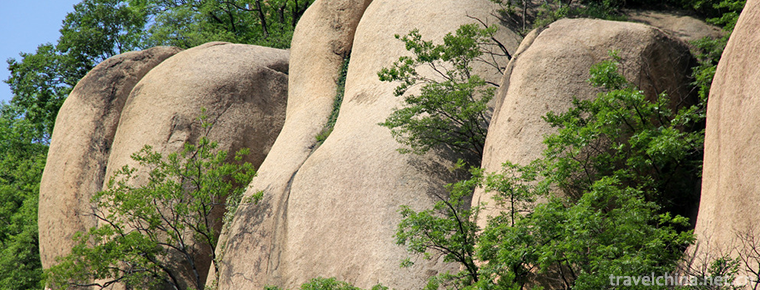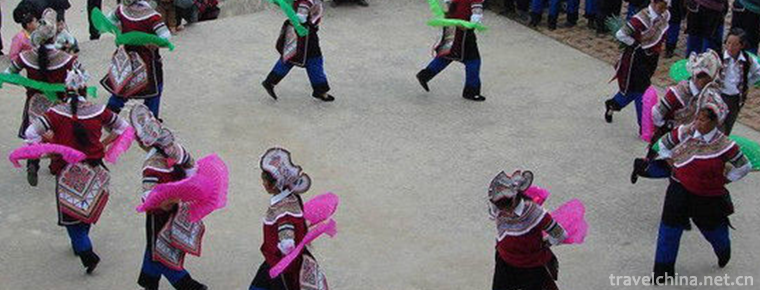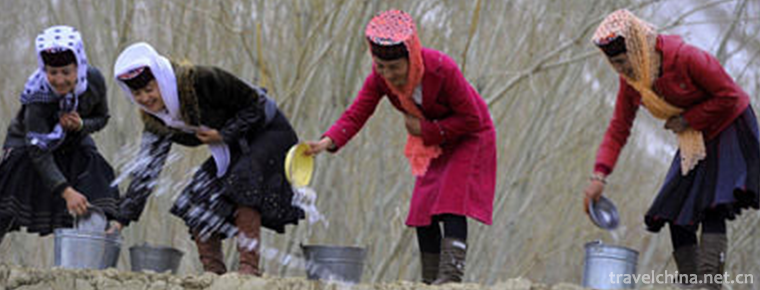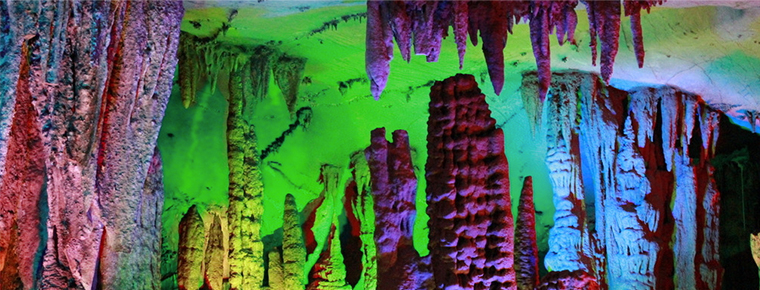Mupa Mipa
historical origin
Mupamipa is the most widely spread myth among the Lahu people. It is a folk literature produced by the Lahu ancestors in order to thank the God of heaven and earth, the creator of human beings, and to teach people how to survive.
Cultural characteristics
Content architecture
"Mupamipa" is the transliteration of Lahu language, meaning "making heaven and earth". Peony Pamipa tells the story of the creation of heaven, earth, sun, moon, stars, plants, animals and people by the God Esha. The poem covers politics, economy, culture, history and other aspects. It is called the Encyclopedia of Lahu national culture.
Mupa Mipa is magnificent, rich in content and has more than 2,000 lines. Because of the different versions circulated among the people, the structure and content of the poem are different. The common edition of Mupa Mipa consists of three parts: the head, the tail and the body. The body is divided into three parts. The first part is "Creating Heaven and Earth", the second part is "Creating Man", and the third part is "How Man Lives". The third part is about how people live, which includes more than ten aspects, such as "marriage between Zadi and Nadi", "first generation", "fire-making", "hunting", "distribution", "fixed-year festival", "building houses", "building farm implements", "planting millet" and "planting cotton".
artistic characteristics
I. Demonstration of Primitive Materialist Thoughts
Mupa Mipa is rich in content and vividly demonstrates the primitive materialism formed by Lahu ancestors in their long-term production and life through the unique narrative style of the epic.
Mupa Mipa tells us in great detail that the world is made up of matter. In Peony Pamipa, the goddess Esha has amazing power. She can create whatever human beings want. However, all her creations are material-based: Esha is a god. In the mythology of many nations, God's creation is "change"; what she needs is "change". This is not the case with Esha. She made the earth from sweat rubbed from her hands and feet and her bones; she made the sun and the moon with her left and right eyes; she made bananas, gourds and other plants with seeds; she taught people to build houses with ordinary bamboo and wood; she taught people to dig iron ore with horse deer antlers, etc. Here, rather than being a god, she is a human being and a hero in the minds of Lahu ancestors in ancient society. She created the world with matter, and the world she created was also made up of matter. The Lahu ancestors may have this understanding, which is unconscious and unconscious. However, it does show that the original materialism thought has come into being among the Lahu ancestors.
Mupa Mipa reveals the essence that labor can create everything through a large number of details. In Mupa Mipa, the God of heaven, Esha, is omnipotent and a genuine god. However, all her creations have paid unthinkable labor. Although she is a god, she is an untiring worker. In the final analysis, she is a heroic image of a worker. In childhood, human beings felt mysterious about the formation of all things in the universe, and could not find the root of their generation. Therefore, it is normal to attribute the generation of all things to God, which is the inevitable fruit of the tree of human primitive thinking. The important philosophical value of the mythical epic Peony Pamipa lies in telling people that even the omnipotent god, if he wants to create all things in the universe, he must pay hard work. Labor can create everything. In ancient times, it was remarkable that Lahu ancestors could have such an understanding.
In primitive society, Lahu ancestors could not scientifically explain the origin of all things in the universe, but could reasonably explain the world with the artistic image of Esha, telling people that the world was made up of matter and that labor could create everything. This shows that they had primitive materialism at that time. This thought has exerted an important influence on the development of Lahu's history and culture.
Mupa Mipa is a long poem creation myth sung by the Lahu people "Bo Kuang Ga Kuo", which mainly spreads in Lancang Lahu Autonomous County, Simao City, Yunnan Province. It is the most popular long poem myth among the Lahu people and the most important work of Lahu folk literature.
On May 20, 2006, Mupamipa was listed in the first batch of national intangible cultural heritage list with the approval of the State Council.
2. Reflection of Primitive
Religious Concepts
In human primitive religious beliefs, religious concepts occupy an important position. The primitive religious beliefs of the Lahu people include natural worship, totem worship, spiritual worship, soul worship and ancestor worship. The poetry myth Mupamipa reflects the primitive religious concept of ancestor worship of Lahu ancestors.
In Mupa Mipa, the primitive religious atmosphere of God's omnipresence and omnipotence permeates all the time. Esha made heaven and earth, orientated heaven and earth, made sun and moon, day and night, and fixed years and months. Esha planted a tree. After the tree was fruited, she dried and cut the fruit into pieces, threw it into the air, and then blew it into the air: the breath she breathed became the wind in the air; the fruit she cut into pines and chestnuts; the leaves fell to the ground. It has become Artemisia wilderness bush, thatched grass bush, Lotus straw Bush and white gulls, pheasants, peacocks, etc. After the right of the tree falls to the ground, it has become a rat, a white belly rat, a flying rat, an owl, etc. After the trunk is cut down, it has become wild boar, an old bear, a bison and so on. Tree Festival has become a bee, a rock bee, an ant, a long snake, a swimming fish and so on.* All things were created by Esha. The way she created everything was magical: Isa was God, with God's power and power. In addition, in Mupamipa, Esha also searched for iron ore, ironmaking, farming tools, building houses, looking for seeds, planting millet and planting cotton for human beings. All these deeds are the deeds of God: she is a god, which can not be done by human beings. This is the typical worship of gods in primitive religion.
In the early days of human society, because of the low level of production, people always seemed powerless in the face of the unpredictable natural forces. Therefore, people place their hopes on various gods, which is the core of primitive religious culture.
In the primitive religious worship of the Lahu people, there are natural worship, totem worship, spiritual worship, soul worship and so on, but none of them can compare with ancestor worship. The Lahu people always equate Esha with their ancestors. In their minds, Esha is both the creator and the ancestor. Lahu people's worship of ancestors always occupies the central position of primitive religion, and the worship of Esha also occupies the central position of ancestor worship. During the year, there are a lot of ancestor worship activities among the Lahu people all over the country. In all ancestor worship activities, the first thing is to offer sacrifices to Esha. Esha, the knowledge of ancestors, has been deposited in the cultural psychology of the Lahu people. In a sense, the worship and sacrifice of Esha is also an extension of the original religious concept of the Lahu people. Therefore, Mupamipa provides living materials for people to study the original religious culture of the Lahu people.
3. Records of the Evolution of Marriage Form
Human marriage has undergone a complex process of evolution. The first form of marriage skill of human beings was primitive group marriage, which later developed into consanguineous group marriage, sub-consanguineous marriage, then dual marriage, and finally established monogamy. In ancient times, the marriage forms of human beings were mainly primitive group marriage, consanguineous group marriage and sub-consanguineous marriage. Monogamy occurs in patriarchal society. For many ethnic groups, monogamy is a matter after entering a civilized society. From primitive group marriage to the emergence of one husband and one security system, it reflects the evolution of human marriage from low to high, and is an important symbol of the development and progress of human society.
The poetry myth Mupa Mipa truly records three stages of the marriage pattern of Lahu ancestors:
First, the age of consanguineous marriage. Mupa Mipa tells a lot of legends about the life of gourd. The so-called "cucurbit stranger" reflects the marriage pattern of consanguineous groups. In the age of primitive consanguineous group marriage, the family centered on the maternal line, and the children knew only that their mother did not know their father. In the legend of the birth of gourd, we can see that brother and sister Zadi Nadi were born in gourd. The gourds here undoubtedly represent mothers. So who is the father of Zadi and Nadi? There is no explanation in the myth. This shows that primitive group marriage and consanguineous group marriage existed widely among the ancestors of Lahu.
Second, the age of consanguinity, marriage and family. Compared with the age of primitive group marriage and I blood group marriage, the emergence of blood marriage and family is a progress of human society. The story of brother and sister's marriage in Mupa Mipa reflects blood marriage and family. Brothers and sisters Zadi and Nadi, who were born in gourd, wanted them to marry when they grew up. In order to achieve their goals, she tried her best. Finally, the brothers and sisters finally got married. The marriage of relatives and sisters is the typical feature of the family system of consanguinity marriage.
Thirdly, the transition period from matrilineal system to patriarchal system. In human society, the transition from matrilineal system to patriarchal system has created conditions for the emergence of dual marriage. Dual marriage is a transitional form of group marriage, a transitional link between group marriage and monogamous individual marriage. It is said in Mupamipa in the late primitive society that three years after the marriage of Nadi and Tuotuo were barren. As a husband, Zadi was pregnant. Strangely, the fetus was pregnant on Zadi's calf for a day. She walked carelessly and shook the fetus off. Nadi saw her heart ache and wrapped the fetus in her clothes. As a result, the fetus got into Nadi's belly. From then on, the pregnant woman was. Some scholars believe that this seemingly ridiculous story hides a real intention, that is, men challenge women's authority. It shows that in that era, men not only competed with women for the dominance of cattle production, but also for the dominance of family life. Even pregnant and childbearing, a unique function of women, men also wanted to have. Therefore, there is a myth of male pregnancy, which should be the product of the transition from maternity to patriarchy.
4. Praise of National Spirit
Mupa Mipa tells the story of the hard struggle of Lahu ancestors with magical and bold imagination. The main artistic image in the works is the God of creation, the ancestor of the Lahu people, and a hero of diligence, wisdom, courage, dedication, distinctive rewards and punishments, and amiable. It is the embodiment of the ideal personality of the Lahu ancestors. She made heaven and earth, made heaven and seven stomachs with her foot bones, made earth bones with her hand bones, made the sun with her left eye and made the moon with her right eye, inspected bananas three times a day and sweated heavily every time, and worked seven days and seven nights to plant a tree. These acts represent a national spirit of perseverance, self-improvement, willingness to contribute, solidarity and friendship. For thousands of years, the national spirit embodied in Mupamipa has provided the Lahu people with the power to understand, defeat and transform nature, and has provided the spiritual impetus for the economic and social development of the Lahu people.
Inheritance mode
Mupa Mipa is a long poem myth and a creation epic. However, the way of inheritance of Mupa Mipa is different from that of other national epics.
I. Group Singing
Most of the folk epics are only used to recite, some for full-time personnel to recite on specific occasions, some for ordinary people to recite, "Mupa Mipa" can be sung. This kind of singing, sometimes with a little performance nature, entertainment components occupy a larger proportion.
Because of the high artistic requirements for lyrics and melodies when singing in public, Mupa Mipa, as a long Taoti myth, embodies the wisdom and painstaking efforts of the Lahu people and fully meets these requirements. The lyrics of Mupa Mipa are popular and concise, with the same rhythm, more duals and relatively fixed tunes. Due to the Lahu nationality's distribution in many places and the influence of various cultures in the residential areas, there are some differences in the singing style of Mupamipa. However, no matter how different, the Yuan style is very beautiful, which conforms to the appreciation habits of the Lahu people. And the lyrics and songs should be appreciated both elegantly and vulgarly.
The singing of Mupa Mipa is usually carried out during the Lahu traditional festivals, religious activities and agricultural leisure period. There are various forms of singing, such as singing by one person, singing by one person, singing by many people, singing by one or two people, singing by groups. Sometimes, many people can take turns singing, the atmosphere is often very warm, singing and chanting, with words and lines, voice and lush, the audience emotional excitement, such as ecstasy, to achieve selflessness. Once the singing activity starts, it usually lasts night and day, and lasts all night. This group singing activity played an important role in the dissemination of Mupa Mipa.
2. The Inheritance of Mupa Mipa
The inheritance of Mupamipa relies heavily on "Gamuko" and "Moba". "Gamuko" is a Lahu language, meaning a person who can sing poems; and "Moba" is also a Lahu language, meaning the host of religious activities, similar to priests and wizards.
Gamuko is a poet, that is to say, a person who can sing "Mupa Mipa" in full length. He is one of the main singers of traditional festivals, religious activities and agricultural leisure time when asked to sing "Mupa Mipa". Moba is different from Gashu. In the view of Lahu people, Moba is a person who can communicate with the gods, and is the link and bridge between people and gods. Because of the high social status of Moba, people have a high demand for Moba. Moba should be able to sing Mupa Mipa in one piece. He should be able to sing all kinds of sacrificial songs, understand national history, astronomy and geography, preside over major ceremonies, know medicine and witchcraft. Only such a person can be respected as "Moba". There are many people who are called "Gamuke". People who are called "Moba" often have only one in two or three villages. Moba usually gives ghosts and divinations, invites souls and cures diseases, presides over sacrifices, and is in charge of singing Mupa Mipa during traditional festivals, religious activities and leisure time.
Moba is the true heir of the poetry myth Mupa Mipa. Moses could marry and have children, but he could not pass his position on to his descendants or open disciples to receive disciples. To become a Mosaic, one must first learn by oneself, often follow the old Mosaic to participate in various activities, close to the old Mosaic, and strive to become an assistant of the old Mosaic. Then, through observation and observation, immersion and observation, one can gradually master the skills of the old Mosaic, and replace it when the old Mosaic is old and frail. Of course, one must become a Mosaic, first of all, a Gashuike. If a person who can sing poems wants to become a Gamuko, he must study the singing of Mupa Mipa modestly and participate in the singing activities of Mupa Mipa so as to gradually become famous.
No matter Gamuko or Moba, they are not taught by clothes or by white envelopes, but recommended and approved by everyone. A person who sings "Mupa Mipa" well will be recommended as Gamuko, a person who can sing poems; a person who has the ability and level of Moba will be promoted as Moba, please go to preside over various religious ceremonies and treat people's illness. Therefore, Gamuko and Moba played a very important role in the inheritance of Mupa Mipa.
Singing way
Mupa Mipa usually raps during Lahu traditional festivals, religious activities or leisure time. It is composed of "Kamuko" (a poet) and "Moba" (a host of religious activities), and can also be accompanied by many or more people to sing in a round. The lyrics are popular and concise, the metrics are fixed, and the dual sentences are in the majority. The melody is beautiful and beautiful, and the modes vary from region to region. The singing is characterized by words, lines and tunes, and rap. Rap often lasts all night, the singer is full of voice and emotion, the listener is intoxicated, most of the participants are in high spirits.
Inheritance and protection
Inheritance significance
While creating material wealth, the Lahu people created valuable spiritual wealth. The poetry myth Mupa Mipa is a bright pearl in its spiritual wealth. Mupa Mipa grew up in the fertile soil of Lahu folk culture. It was handed down from generation to generation and absorbed almost all the nutrients of Lahu folk culture. It was an important carrier of Lahu history and culture.
Mupamipa is an indispensable precious material for the study of Lahu's history and culture, a carrier of Lahu's culture, and a link to maintain Lahu's spiritual life.
Inheriting characters
Li Zago, male, was born in 1939. In June 2007, Li Zhago was selected as the representative successor of the first batch of national intangible cultural heritage projects and declared in Puer City, Yunnan Province. Project name: Mupa Mipa.
Li Zani, male, born in 1943. In June 2007, Li Zani was selected as the representative successor of the first batch of national intangible cultural heritage projects and declared in Puer City, Yunnan Province. Project name: Mupa Mipa.
protective measures
In March 2003, the Yunnan Provincial Department of Culture began its pilot census in Lahu Wa Autonomous County of Menglian Dai Nationality. Puer Cultural Bureau issued a series of measures and officially established the intangible cultural heritage protection center in 2010. The grass-roots units gradually established the heritage base and the heritage institute. The Five-Year Plan for the Protection and Inheritance of Non-Heritage Sites was promulgated to clarify the development requirements for the protection and inheritance of Non-Heritage Sites, and to equip corresponding personnel. They are specifically responsible for the identification, preservation, dissemination, protection and utilization of non-Heritage Sites, so as to make the protection of Non-Heritage Sites more standardized and scientific.
Up to 2007, after collecting and sorting out, Mupa Mipa has been published (Yunnan People's Publishing House, 1978, Liu Huihao sorted out). "Mupamipa Guge Canmuke" (Lahuwen, Yunnan Ethnic Publishing House, 1984, collated by Li Wenhan). "Mupa Mipa" (a comparison between Lahu and Chinese, Yunnan Ethnic Publishing House, 1989, collated by Li Zayo). All the arias of Mupa Mipa have been included in Lahu Folk Literature Integration (China Folk Literature and Art Publishing House, 1988).
social influence
Important activities
On November 23, 2011, at the 7th National Folk Song and Dance Exhibition in Junan Province, Li Zani, the inheritor of the national intangible cultural heritage, sang the creation myth of the Lahu nationality, Peepa Mipa.
On the evening of April 7, 2016, the Lahu folk song and dance poem Mupamipa premiered in Lancang County National Theatre, thus opening the prelude of Lancang Lahu gourd festival.
Honorary commendation
From January 15 to 27, 2016, the 13th New Drama Exhibition of Yunnan Province was held in Kunming, hosted by Yunnan Provincial Culture Department, Kunming Theatre and Yunnan Academy of National Arts. The dance poem Mupa Mipa performed by Lancang County Ethnic Culture Task Force of Puer City won the third prize for performance, and Luo Wenjun's dance poem Mupa Mipa won the third Prize for performance.
Cultural anecdotes
I. The Legend of Creating Heaven and Earth
Long ago, there was no land, no sky, no wind and rain, no sun, moon and stars, no day and night, no discrimination between southeast and northwest, everywhere confused.
In the sleeping universe, only the god, Esha, opened her eyes: if the universe was compared to a spider web, she would sit in the middle of the web = she was meditating and restless. Second, she had broken nine mattresses, stepped on a few shoes and sweated three times.
Esha rubbed the sweat on her hands and feet, made four pillars of gold, silver, copper and iron, and made four big fish of gold, silver, copper and iron. She supported the pillars on the back of the fish, erected four skylights and four earth beams, laid the rafters on the skyline, laid the rafters on the ground beams, and rubbed the sweat on her hands and feet. She rubbed them into many clay States and made a sky net of 77,000 mud balls. Seventy-seven thousand mud masses form a net. From then on, with the sky and the earth, the sky is like a cover and the earth is like a board.
The sky and the earth were made, but the sky had no bones, and it was very soft; the earth had no bones, and she thought for a long time about sinking down. At last, she took out the bones from her body painfully, made the skeleton from her hands, made the skeleton from her feet, and made the skeleton from her feet. The sky and the earth were supported by the bones and hardened.
But she was not reassured. How high is the sky and how thick is the ground? Will heaven and earth collapse? She sent pangolins to check, pangolins came back and said that the heaven and earth are the same thickness, but the sky is small, the earth is bigger. To make the sky cover the earth, the sky should be enlarged and the earth narrowed.
Etha frowned and found the reason. Her assistant in heaven-making is Zaro, and her assistant in earth-making is Naro. Zaro is careless and lazy, Naro is careful and diligent. It must have been Zaro's laziness that made the sky small. No way, she had to stretch the sky and shrink the ground. The sky is stretched up like an iron pot; the ground is narrowed, wrinkled, uneven, and the high places become beams, and the low places become riverbeds.
Heaven and earth have, but there is no sun, moon, stars. How does everything grow without sun, moon and stars?
Esha made the sun with her left eye and the moon with her right eye. The sun and the moon are there, but the sun is not clear and the moon is not bright. Esha put the fire into the sun and the firefly into the moon. But the sun and the moon do not move. Isa wondered and asked the sun and the moon. The sun and the moon say that we have warmth and light, but no weapons to defend ourselves.
Later, legend has it that because there is no weapon to defend oneself, there are leopard bites on the sun and black shadows on the moon when frogs step down.
After thinking for a long time, she decided to pull out her hair as a silver needle and breathe out her breath as a gold needle. She put a silver needle in the moon's head and a gold needle in the sun's head. From then on, anyone who peeps at the moon and the sun for a long time will be stabbed in the eyes by silver and gold needles.
With the protection of gold and silver needles, the sun and moon began to move in the sky.
The sky, the earth, the sun and the moon came, and she rubbed the sweat from her hands and feet and made stars all over the sky. She stipulates that the sun rotates once every 12 days and the moon loses 12 times a year.
Legend of Creation
With heaven and earth, Esha wants to make all things.
Esha decided to look for water first. She rubbed the sweat from her hands and feet and made a duck and a duck. She gave the duck a pair of silver wings, a pair of golden feet, and asked the duck to find water. The duck flew three times in the sky and underground, and found that there was no water everywhere. They suggested that Esha dig ponds on the hills, pools at the foot of the hills, and a variety of banana forests, and there would be water.
Upon hearing the duck's words, the God Esha led his assistants Zaro and Naro to dig a nine-day pond and open a nine-day trench. The pool dug is seventy-seven feet deep and the trench opened seventy-seven feet long. Quail opened Esha's box and took out the seeds. White birds and ducks scattered the seeds. Seventy-seven ditches and seventy-seven mountains were removed. The seeds sprouted and plantains grew. Since then, there have been bananas in the world. She also made crabs, frogs and sparrows. Crabs smash the roots of bananas with pliers. Water flows out of the roots of bananas, fills the ponds and flows to the river.
Elsa planted another tree, whose trunk did not branch, which did not grow leaves or flowers. She asked Zaro and Naro to branch and germinate the tree and let it blossom and bear fruit. Zaro came under the tree and opened his palm. The tree branches and branches. Naro came under the tree and pointed to her Baotou. The tree gave out its leaves. Naro pointed her finger at her earrings, and a bunch of safflower sprouted from the branches, which soon produced fruit.
Etha transformed forests and grasses from fruit powder, birds from leaves, and animals from branches. However, new problems have arisen. Birds can only fly, animals can only walk, can not speak. Esha dug out a fountain of wine, and it came out like a river, sweet as honey. The beasts drink the wine from the wine fountain and speak their own words; the birds drink the wine from the wine fountain and sing their own songs.
3. The Legend of the Birth of Hulu
Ursa opened the box and found a gourd seed. She sprinkled gourd seeds on the ground and covered them with straw ash. After seven rounds and seven days, the vines of the gourd grew out, and after another seven months, the gourd became mature. However, the gourd is too big to be picked by Zaro and Naro.
Behind her house, there were countless fruit trees, full of fruit. Every day, many wild animals come here to eat fruit. One day, the owl stood at the top of the tree and got a fruit that hit the muntjack's nose impartially. The suede was frightened, ran around, frightened the bison, and broke the gourd vine with one foot. The gourd vine was broken, and the huge gourd fell down and rolled away quickly.
When she heard that the gourd had disappeared, she was in a hurry. She asked everyone to look for it, looking for it from east to west, but she could not see the shadow of the gourd. Isa wondered if the gourd would fall into the river or the sea. She made a pair of crabs and asked them to search in the river and sea.
Crabs got into rivers and seas and finally found gourds. It clamped the gourd ashore with pliers. The gourd was clamped by the crab's pliers and its neck was narrowed. In the sea, gourds drink too much water, and their stomachs swell up big and round. Since then, the gourd has become a thin neck, big belly.
Esha took the gourd home and put it on the drying table. Seventy-seven days passed and finally the wet gourds were dried. On this day, people's voices came out of the gourd, and Isa was shocked. How could there be people's voices in the gourd? Elsa was so fond of it that she hurried to call the millet sparrow and let it peck at the gourd and let someone out. The millet sparrow has an iron beak, nine feet and nine inches long. It pecked the gourd for three days and three nights, and the iron beak was worn out without pecking the gourd.
Then she called a pair of mice and ordered them to eat gourds. Rat's teeth, like a row of iron files, they gnawed three days and three nights, and finally gnawed two big holes in the gourd.
With a burst of laughter, two children crawled out of the gourd hole. The boy's name is Zadi and the girl's name is Nadi. Ursa looked at Zadi and Nadi, her mouth shut with joy. She decided to raise Zadi and Nadi.
Legend of Brothers and Sisters Marriage
Zadi and Nadi flute very fast. They grow for one day, equal to ten days for ordinary people; they grow for one year, equal to ten years for ordinary people. Zadi is white and plump, and Nadi is like the moon in the fifteenth year. The beast saw Zadi and Nadi and wanted to eat their meat. Esha invented rope buckles, traps and nets, and all the beasts who wanted to eat Zadi and Nadi fell into traps and nets.
Zadi and Nadi grew up day by day. Nadi is gentle, virtuous and industrious. She picks wild vegetables, picks mushrooms and does housework every day. Zadi is skillful and skillful. He makes stone axes and bamboo knives all day to prepare for hunting in the future. They also learned how to make and blow reeds, how to make and play reeds, and how to meet with each other in the mountains.
Brothers and sisters finally grew up. One day, she told Zadi and Nadi that they should get married, like the sun and the moon - a pair, live together, live together.
Zadi and Nadi were surprised to hear. And they said, We are brothers and sisters, and we cannot be husband and wife. But,
Sha disagreed. One of Zadi and Nadi ran to Mount Aki and the other to Mount Ayo, far apart. They hide away, just don't want to be husband and wife. But the God of heaven, Esha, has great power. She used magic, Akishan and Ayo were together, and the brothers and sisters met again.
Zadi and Nadi just don't want to be married. When they were angry, Zapi ran up to the moon and hid; Nadi ran up to the sun and hid. Etha looked at it and laughed secretly. She made an emotional drug for bees to fly around the sun and moon. Zadi and Nadi could not help but leave the sun and the moon and walk together when they heard the drug.
Nadi likes to play bamboo strips, Zadi likes to play lusheng. Elsa made another kind of Acacia medicine and put it on the disdain and the reed. As soon as Zadi played Lusheng, he couldn't help thinking of his sister; as soon as Nadi played the note, he couldn't help thinking of his brother. They finally fell in love and fell in love. In front of Isa, they were shy and pretended to be innocent; behind the scenes, they became husband and wife and lived happily together.
V. Legends of Human Reproduction
After Zadi and Nadi got married, they had no children for three years. Ursa was in a hurry. She found a silver needle and tied it on both of them. Soon, something strange happened. Nadi, wife, was not pregnant, but Zadi, husband, was pregnant. Strangely enough, Zadi's fetus was conceived on her calf. One day, he walked carelessly, shaking off the fetus on his calf, and Nadi on the side saw her heart ache. He wrapped the fetus in his clothes. Suddenly, the fetus got into Nadi's stomach. From then on, it's women who are pregnant and have children.
From winter to spring, the fetus grew up day by day, and Nadi's body changed. She's going to have a baby, but where is it? Nadi went out, chose a red indigo forest, and gave birth to the child under the red indigo tree. The blood she shed during childbirth stained the leaves of indigo red and the roots of indigo red. From then on, red indigo became red.
When the God Isa counted the days, she knew that Nadi was ten months pregnant and that the baby was due to be born. She found Nadi and found her face pale. Only when she asked, did she realize that Nadi had given birth to a child, but there were too many children in a single birth, a total of ninety-eight pairs, like a litter of pigs and puppies. Because she had too many children, she couldn't bring them back and could not bring them up, so she left them in the wild.
She was so surprised that she called all the animals and asked them to find the children. The Bumblebee and the magpie found the child, but they did not tell the truth. Esha took up the golden stick and silver stick and beat the Bumblebee into two pieces. From then on, the bumblebee's waist broke. Elsa punished the magpie not to build a nest at high altitudes. From then on, the magpie's nest could only be built half way down the mountain. The sour bee found the child and came back to tell the truth. Esha rewarded it, allowing it to put honey on its head and feet. There will always be flowers that can't be picked and honey that can't be brewed.
The child was found back, but there were too many children for the Zadi couple to raise. She also called twelve kinds of animals, such as dogs, pigs, cows and tigers, so that they could help them to feed their children with their own milk. When these children grow up, they are named after twelve animals.
Too many children, no clothes, can not resist the cold. Etha took out a little heart and laid it on the top of the mountain. Suddenly there was a thunderclap and a thousand golden lights flashed out. Mars flew up the hillside and was snatched by a mouse. It took the fire to the tree. Later, people promised to give the mice food, and then they changed the fire seeds from the mice. With fire, man began to burn barren hills and grow crops; with crops, man could eat, drink and multiply.
In order to make people live better, she divided different areas of production and life for different nationalities. She also taught people to make tools, learn to hunt, build houses, grow millet, grow cotton, carry out production, and helped people formulate the original distribution system. From then on, human beings lived happily on the earth.





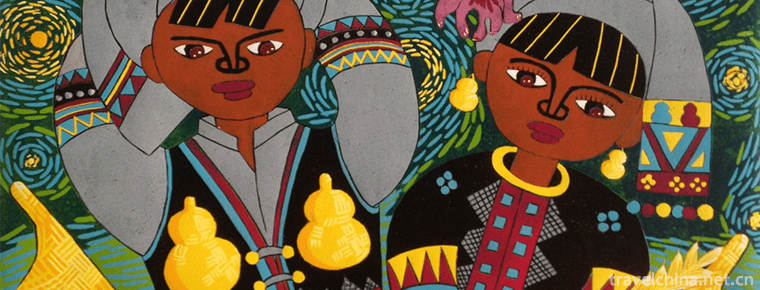
-
Chengdu Panda Base
No. 1375 panda Road, Chenghua District, Chengdu city, Sichuan province.
Views: 223 Time 2018-09-28 -
Xixi National Wetland Park
Xixi National Wetland Park is located in the west of Hangzhou City, Zhejiang Province. It is only 6 kilometers away from Wulin Gate, the main city of Hangzhou, and 5 kilometers away from West Lake..
Views: 184 Time 2018-12-07 -
Mingyue Gorge Scenic Area
Mingyue Gorge is located in the eastern section of Jialing Jiangxi Lingxia, Guangyuan, Sichuan Province. It covers an area of 6.1 square kilometers and is about 33 kilometers.
Views: 145 Time 2019-02-07 -
Fuzhou Reviews
Fuzhou dialect commentary is a unique traditional form of storytelling in Fuzhou dialect of Fujian Province, which is popular in Fuzhou, Fujian Hou, Yongtai, Changle, Lianjiang.
Views: 128 Time 2019-04-30 -
Music dance
Musical dance is popular on the South Bank of the Red River, so it is also known as "Jiangwai" Yi dance. The Yi language is called "Zai Bi", which means jumping up in pairs. .
Views: 289 Time 2019-05-11 -
Tajik Water Diversion Festival and Seeding Festival
In Tashkurgan Tajik Autonomous County of Xinjiang, Tajik Water Diversion Festival and Seeding Festival are Tajik agricultural festivals. In Tajik, the sowing Festival is called "Hamozivast" .
Views: 225 Time 2019-06-17 -
Longtan Karst Cave Scenic Spot
Longtan Karst Cave Scenic Area is located at the foot of longcuban mountain, Miyi Baima Town, Panzhihua City, Sichuan Province, with an altitude of 1500 meters. It is a provincial-level scenic spot and a national AA level tourist area..
Views: 117 Time 2020-10-15 -
Bowang mountain
Bo (B ó) Wang mountain, also known as Bowang mountain. Bowang mountain is one of the most important breeding and living places of the ancient Bo nationality. It was known as lunzhudadun and shitoudazhai in ancient times.
Views: 160 Time 2020-10-16 -
Ganzi milk dregs
The traditional biscuit snack "Tui" is made of milk dregs and butter. And made from milk dregs. After the milk i.
Views: 198 Time 2020-12-06 -
Natural disasters in Mianyang
Earthquake: Mianyang City is located in the western mountain area, namely Pingwu, Beichuan and Anxian mountains, and the Northwest Mountainous Area of Jiangyou, which is one of the earthquake prone areas in Sichuan Province. .
Views: 126 Time 2020-12-14 -
History and culture of Mianyang
Located 47 kilometers south of Santai County, Qijiang ancient town was once the capital of Qi state during the spring and Autumn period and the Warring States period. Every year on the 27 to 28 May of the lunar calendar, all the male and female believers around.
Views: 222 Time 2020-12-14


